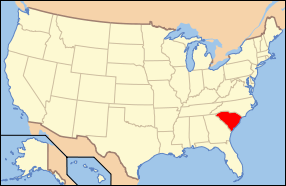Biggin Church Ruins
|
Biggin Church Ruins | |
|
Biggin Church Ruins in 1940 | |
  | |
| Location | 2 miles northeast of Moncks Corner on South Carolina Highway 402, near Moncks Corner, South Carolina |
|---|---|
| Coordinates | 33°12′45″N 79°58′1″W / 33.21250°N 79.96694°WCoordinates: 33°12′45″N 79°58′1″W / 33.21250°N 79.96694°W |
| Built | ca. 1761 |
| NRHP Reference # | 77001215[1] |
| Added to NRHP | December 13, 1977 |
The Biggin Church Ruins are the ruins of a church in Berkeley County, South Carolina. Biggins Church is its name in the USGS Geographic Names Information System.[2] The ruins are about 2 mi (3 km) from Moncks Corner, South Carolina, near the intersection of South Carolina Highway 402 and State Highway 8-376.[3] The church has been burned three times since it was first constructed in about 1711. It was the church of the parish of St. John's, Berkeley. The ruins are from the church built in 1761 and its reconstruction in 1781. It was included in the National Register of Historic Places on December 13, 1977.[1][4][5]
History
The site for the church, Biggin Hill, is probably named for Biggin Hill in the London Borough of Bromley. The Parish of St. John's, Berkeley was created in the South Carolina Assembly Act of 1704 and the Church Act of 1706. St. John's, Berkeley had the largest area of the original ten parishes of the Province. These parishes served both religious and civil functions in the colony. The land for the church was donated by the Landgrave John Colleton.[6][7][8]
The first church was built around 1711 to replace a wooden building that had been used for religious services. This church burned in a forest fire around 1755.[5][7][9]
The church was replaced with a new building in 1761. In this period, parishioners included Henry Laurens and William Moultrie.[10] During the Revolutionary War, British troops used the church as a depot. As they retreated, the church and stores were burned in 1781.[5][6] The church was rebuilt.[11]
The church was used up to the Civil War. During the war, the furniture was removed and the church building was damaged.[11] The church was neglected. Around 1886,[7][12] 1890,[10] or the 1890s.[6] the church was burned in a forest fire. After the fire, its bricks were scavenged for other construction projects.[6][7]
Architecture
The church was a rectangular brick building about 30 ft (9 m) by 60 ft (18 m). It was originally done in English bond. Currently, only two walls remain. One wall was probably the main entrance. It has a large portal with Gibbs surround that is flanked by two windows on the left and on the right. The windows are arched with brick voussoirs. The other wall is the end of the church with a door flanked by windows on the left and right. There are quoins at the corner and a water table, which is horizontal projecting band, made with rounded bricks near the base of the wall.[5]
A mural tablet in memory of an early rector of the parish was moved from Biggin Church to its former chapel of ease, Strawberry Chapel, which is about 10 mi (16 km) away.[11] The silver Communion service from Biggin Church, which had been hidden at the end of the Civil War, was found buried in a barn at the Combahee Plantation in 1947. It is now at Strawberry Chapel.[6][11]
There is a cemetery nearby that is still used.[13] It includes the grave of Sir John Colleton III, the great grandson of the Lord Proprietor.[14]
Additional photographs of the ruins are available.[6][15]
References
- 1 2 National Park Service (2009-03-13). "National Register Information System". National Register of Historic Places. National Park Service.
- ↑ "Biggins Church". Geographic Names Information System. U.S. Geological Survey. Retrieved 30 April 2009.
- ↑ "33.2125,-79.966944". Google Maps. Google. Retrieved 9 May 2009.
- ↑ "Biggin Church Ruins, Berkeley County (S.C. Hwy. 402, Moncks Corner vicinity)". National Register Properties in South Carolina. South Carolina Department of Archives and History. Archived from the original on 4 May 2009. Retrieved 7 May 2009.
- 1 2 3 4 McNulty, Kappy (March 9, 1977). "Biggin Church Ruins" (pdf). National Register of Historic Places Inventory - Nomination Form. National Park Service.
- 1 2 3 4 5 6 Stoney, Samuel Gaillard; Simons, A.; Lapham Jr., Samuel (1989). Plantations of the Carolina Low Country (7th ed.). Mineola, New York: Courier Dover Publications. pp. 66–67, 180. ISBN 0-486-26089-5.
- 1 2 3 4 "Biggin Church - 1712". St. John's Parish Berkeley. ancestry.com. Retrieved 7 May 2009.
- ↑ Smith, Henry A.M. (1909). "Inscriptions of the Monuments in the Church-Yard in the Parish Church of St. John's Berkeley". The South Carolina Historical and Genealogical Magazine: 171–186. Retrieved 9 May 2009.
- ↑ Dalcho, Frederick (1820). An Historical Account of the Protestant Episcopal Church in South Carolina. Charleston, South Carolina: E. Thayer (Theological Book Store). pp. 271–274.
- 1 2 Barefoot, Daniel W. (1999). Touring South Carolina's Revolutionary War Sites. Winston-Salem, North Carolina: John F. Blair, Publisher. pp. 44–45. ISBN 0-89587-182-3.
- 1 2 3 4 Thomas, Albert S. (1957). A Historical Account of the Protestant Episcopal Church in South Carolina. Columbia, South Carolina: R.L. Bryan Co. pp. 186–189.
- ↑ Clark, John F.; Pierce, Patricia A. (2003). Scenic Driving South Carolina. Guilford, Connecticut: Globe Pequot. p. 132. ISBN 0-7627-1139-6.
- ↑ "Biggin Parish Church Cemetery". ancestry.com. Archived from the original on 31 March 2009. Retrieved 9 May 2009.
- ↑ Federal Writer's Program of the Works Progress Administration (1941). South Carolina: A Guide to the Palmetto State. New York: Oxford University Press. p. 300. ISBN 978-1-60354-039-1.
- ↑ Nichols, Fred; Waterman, Thomas T. "Biggin Church (Ruins), Cooper River, West Branch, Moncks Corner vicinity, Berkeley County, SC (Photographs)". Historic American Buildings Survey. National Park Service. Retrieved 9 May 2009.
| Wikimedia Commons has media related to Biggin Church Ruins. |
%2C_Cooper_River%2C_West_Branch%2C_Moncks_Corner_vicinity_(Berkeley_County%2C_South_Carolina).jpg)

